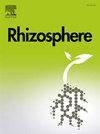用引物对鉴定芸苔菌生理小种
IF 3.4
3区 生物学
Q1 PLANT SCIENCES
引用次数: 0
摘要
根腐病是一种由根腐病病原——芸苔菌侵染引起的土传病害,根腐病可直接给十字花科作物造成巨大的经济损失。芸苔菌潜伏孢子活性高,感染率高,传播渠道广。油菜在田间的表现往往是由多个生理小种的混合侵染引起的,这种混合侵染往往给抗油菜植物的选育带来很大的挑战。本研究通过对球茎根微种特异性引物SCL14 (UP/LP)、PBRA_000030-2 (F/R)、PBRA_000303-1 (F/R)、PBRA_009348-2 (F/R)和Novel342-1 (F/R)的检测系统,建立了一套用于油菜主要生理小种鉴定的多分子标记体系。对棒根生理小种进行分子鉴定,鉴定出1号、4号、7号、9号、11号5个小种。本研究使用的引物特异性较强,有的菌株不仅被鉴定为4号,而且被鉴定为7号,如菌株P2、P3、P4,有的菌株被鉴定为1号,如菌株P60。4号小种在采样点出现频率最高、分布最广,说明4号小种是油菜科优势种。根据采样点的人种分布,发现分离菌株分化程度较高,致病类型较多。本研究将前人研究中获得的用于芸苔属植物分子鉴定的引物进行改进和组合,形成一种多分子标记方法来鉴定芸苔属植物生理小种分离物,为利用分子标记鉴定芸苔属植物分离物提供理论依据。本文章由计算机程序翻译,如有差异,请以英文原文为准。
Primer pairs to identify physiological races of Plasmodiophora brassicae
Clubroot is a soil-borne disease caused by infection with Plasmodiophora brassicae, the causal agent of clubroot, and clubroot can directly cause enormous economic losses in cruciferous crops. The latent spores of P. brassicae are highly active, have a high rate of infection, and are transmitted over a wide range of channels. The manifestation of P. brassicae in fields is often caused by the mixed infection of multiple physiological races, and such mixed infections often pose a substantial challenge to the breeding of plants that are resistant to P. brassicae. In this study, a set of multiple molecular markers for the identification of the main physiological race of P. brassicae was established by utilizing a system to detect the clubroot microspecies-specific primers SCL14 (UP/LP), PBRA_000030-2 (F/R), PBRA_000303-1 (F/R), PBRA_009348-2 (F/R), and Novel342-1 (F/R). The molecular identification of clubroot physiological race resulted in identifying of five such races, including No. 1, 4, 7, 9, and 11. The primers used in this study were more specific, and some strains were not only identified as No. 4 but also as No. 7, such as strains P2, P3, and P4, or as No. 1, such as strain P60. The highest frequency and widest distribution of the small species No. 4 in the sampling site indicated that race No. 4 is the dominant race of P. brassicae. Based on the distribution of race in the sampling site, it was found that the isolated strains of P. brassicae were more differentiated and caused more types of disease. In this study, the primers obtained for the molecular identification of P. brassicae in previous studies were improved and combined to form a multi-molecular marker method to identify the physiological race isolates of P. brassicae, which will provide a theoretical basis to identify the isolates of P. brassicae using molecular markers.
求助全文
通过发布文献求助,成功后即可免费获取论文全文。
去求助
来源期刊

Rhizosphere
Agricultural and Biological Sciences-Agronomy and Crop Science
CiteScore
5.70
自引率
8.10%
发文量
155
审稿时长
29 days
期刊介绍:
Rhizosphere aims to advance the frontier of our understanding of plant-soil interactions. Rhizosphere is a multidisciplinary journal that publishes research on the interactions between plant roots, soil organisms, nutrients, and water. Except carbon fixation by photosynthesis, plants obtain all other elements primarily from soil through roots.
We are beginning to understand how communications at the rhizosphere, with soil organisms and other plant species, affect root exudates and nutrient uptake. This rapidly evolving subject utilizes molecular biology and genomic tools, food web or community structure manipulations, high performance liquid chromatography, isotopic analysis, diverse spectroscopic analytics, tomography and other microscopy, complex statistical and modeling tools.
 求助内容:
求助内容: 应助结果提醒方式:
应助结果提醒方式:


